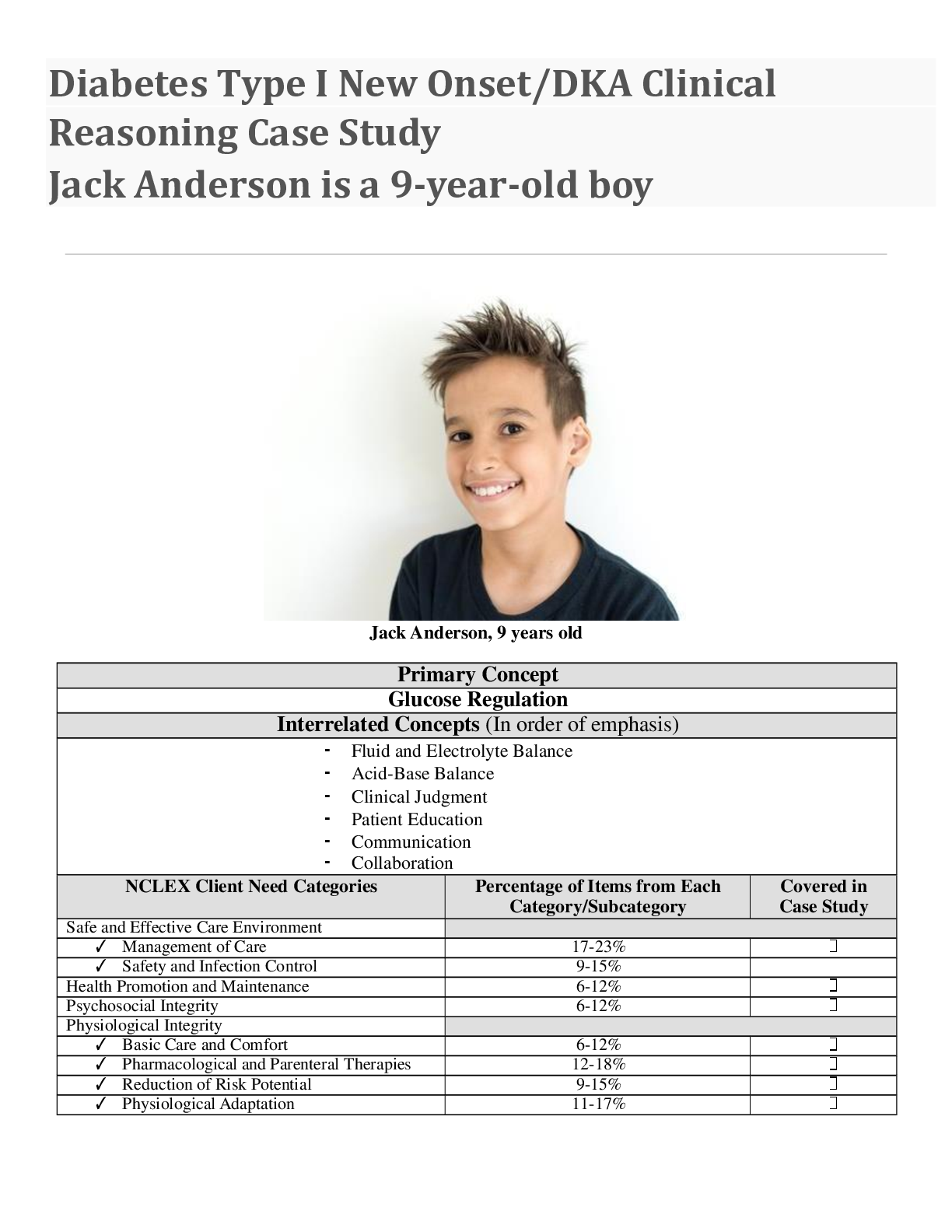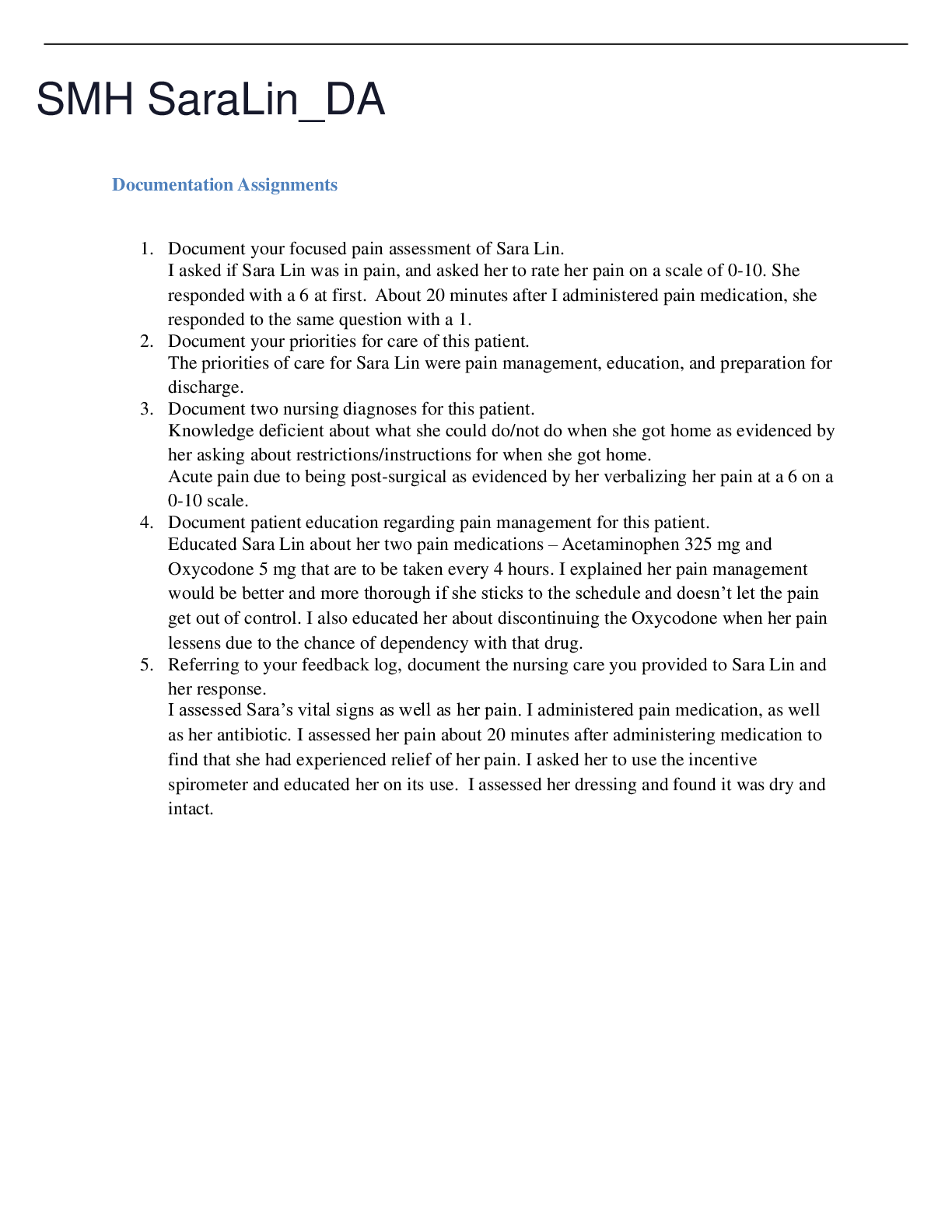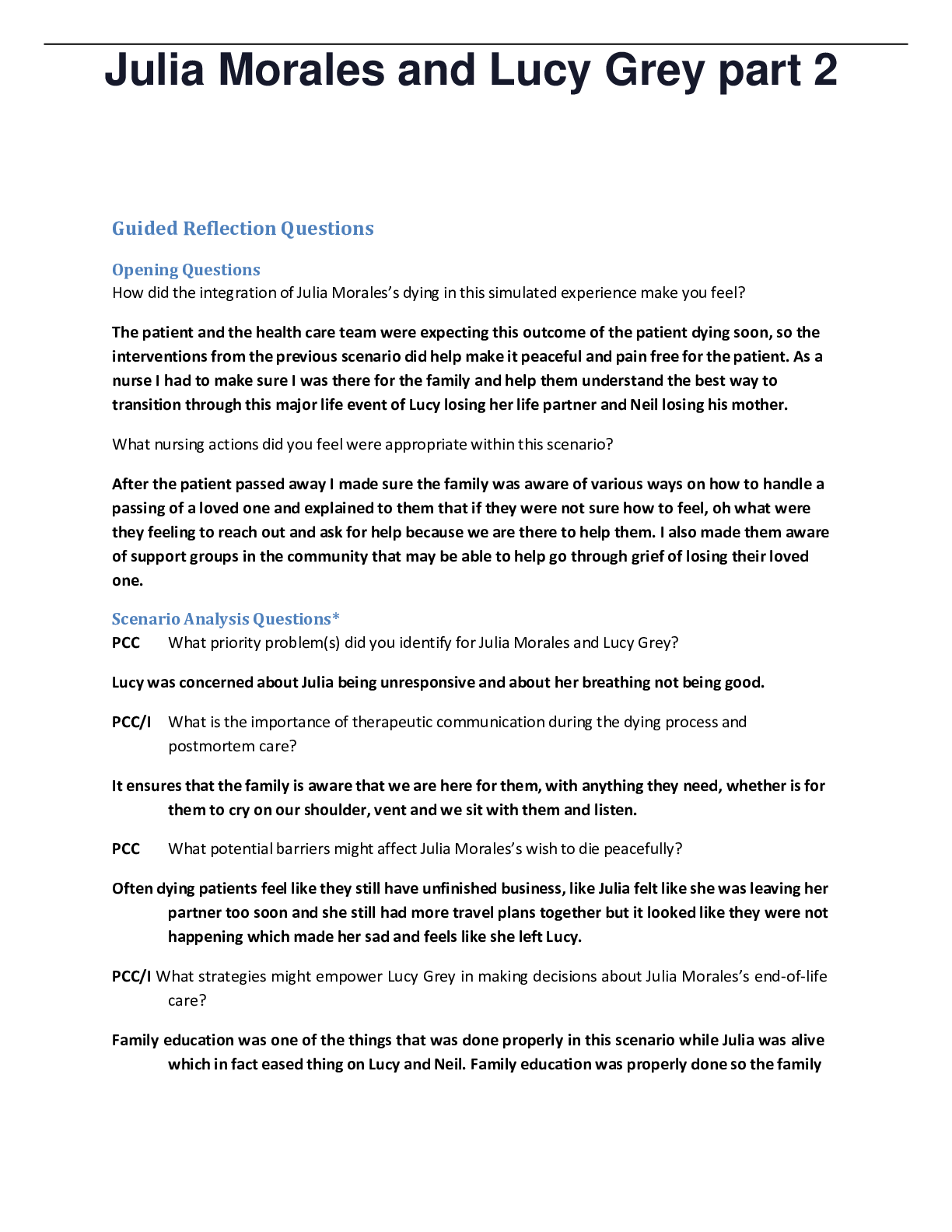*NURSING > EXAM > PPH-(Fatime Sanogo) Post-Sim Questions,WELL EXPLAINED WITH VERIFIED ANSWERS. (All)
PPH-(Fatime Sanogo) Post-Sim Questions,WELL EXPLAINED WITH VERIFIED ANSWERS.
Document Content and Description Below
Ms. Sanogo is Muslim and she has been in the United States for 7 months. She speaks limited English. During patient care, she expresses that she is feeling sad because she is away from her family in M... ali, West Africa. What are some methods that the nurse would take to establish therapeutic communication with Ms. Sanogo? (Select all that apply) Your Response: Correct Response: Correct! Be an active listener during interactions with the patient and her husband Use a translator to give information in two or three different ways if needed Examine and be aware of one’s own sociocultural upbringing Explanation: Nurses can be more aware of another person’s cultural differences by understanding what has shaped their own values and beliefs. To gain the patient’s and her husband’s trust and encourage them to share important information, the nurse would use active listening skills. The nurse would incorporate a translator in person or over telecommunications to give the patient and her family member information in several different ways, to ensure their understanding and overcome any cultural barriers that may be present. While most female patients prefer women to provide care, the Muslim culture does allow for a male provider to attend to female patients. The husband is allowed to be present during the birth of a child and while his wife is being assessed for birth complications. It is not a therapeutic intervention to share experiences that are personal or from other patients, because each person’s situation is individual and it could break privacy practices. Ricci, S. Essentials of Maternity, Newborn, and Women’s Health Nursing, 4th Edition, p. 45 QUESTION 2: What were the identifiable risk factors that indicated postpartum hemorrhage for Ms. Sanogo? (Select all that apply) Your Response: Correct Response: Correct! Second stage of labor lasting more than 3 hours Birth within the past 24 hours A 9 lb (4,082 g) infant Explanation: The risk factors notable for Ms. Sanogo were that she delivered within the past 24 hours, she delivered a large-for- gestation infant, and her second stage of labor was prolonged. The postpartum woman benefits by breastfeeding after delivery due to the natural release of oxytocin. A multiparous woman would be at risk for postpartum hemorrhage. Ricci, S. Essentials of Maternity, Newborn, and Women’s Health Nursing, 4th Edition, p. 800 QUESTION 3: Oxytocin is administered to Ms. Sanogo in order to minimize blood loss. Which of the following measures would the nurse take to evaluate the effectiveness of the oxytocin administration? (Select all that apply) Your Response: Correct Response: Correct! Obtain heart rate and pattern, blood pressure, and respiratory rate Determine the consistency, position, and placement of the fundus Assess her pain level using a scale of 0 (no pain) to 10 (most pain) Check Peri-Pad for amount, color, odor, and consistency of lochia Explanation: Oxytocin is a uterotonic medication that leads to contraction of the uterine muscles. This contraction could lead to the patient experiencing significant pain; thus, obtaining the patient’s pain level is important in determining the drug’s efficacy. Monitor the patient’s vital signs to identify any adverse effects due to oxytocin administration. Fundal and lochia assessments are important to determine if the oxytocin therapy is effective at minimizing the blood loss. Auscultation of lung and bowel sounds would not identify if oxytocin was minimizing uterine blood loss. Ricci, S. Essentials of Maternity, Newborn, and Women’s Health Nursing, 4th Edition, p. 806 Lippincott Procedures, Oxytocin administration, postpartum QUESTION 4: During the fourth stage of labor, Ms. Sanogo, who delivered vaginally, experiences excessive blood loss. Which patient finding would indicate that Ms. Sanogo is experiencing a mild degree of shock? Your Response: Correct Response: Correct! Capillary refill 3½ seconds Explanation: Capillary refill is prolonged at more than 3 seconds and is an indication of mild shock, along with diaphoresis, cool extremities, and maternal anxiety. A urinary output of 30 mL (1 oz) per hour or greater and heart rate between 50 and 100 bpm are normal. A late sign of shock is narrowing pulse pressure and drop in blood pressure below 90 mm Hg systolic and 40 mm Hg diastolic. Ricci, S. Essentials of Maternity, Newborn, and Women’s Health Nursing, 4th Edition, p. 805 Lippincott Advisor, Shock (hypovolemic) QUESTION 5: Which of the following uterotonic drugs would the nurse anticipate being used after oxytocin (Pitocin) to manage postpartum hemorrhage? Your Response: Correct Response: Correct! Misoprostol (Cytotec) Explanation: The nurse would anticipate the use of misoprostol following oxytocin when there is continued vaginal blood loss. Methylergonovine maleate and carboprost tromethamine are uterotonic agents, but they would be given after oxytocin and misoprostol to control early postpartum hemorrhage. Terbutaline sulfate is a tocolytic agent that prevents uterine muscle contraction, which could lead to further uterine hemorrhage. Ricci, S. Essentials of Maternity, Newborn, and Women’s Health Nursing, 4th Edition, p. 800 QUESTION 6: Ms. Sanogo’s husband explained that their culture believes in placing beads or amulets at the female’s waist. What is a culturally competent measure that the nurse can provide to this family during the event of postpartum hemorrhage? Your Response: Correct Response: Correct! Permit the use of beads or amulets as they will allow the parents to express their spirituality Explanation: The patient’s husband expressed that their culture uses beads or amulets to provide the mother with spiritual strength and/or for medicinal purposes. Because these items are not causing any harm to the patient’s condition, she should be allowed to use them. Postpartum hemorrhage can be a serious complication of delivery, and the patient’s needs must be incorporated into the plan of care. The nurse would take measures to promote family-centered care by collaborating with the patients’ family members. Ricci, S. Essentials of Maternity, Newborn, and Women’s Health Nursing, 4th Edition, p. 45 QUESTION 7: What is the most effective and safe way for the nurse to perform fundal massage? Your Response: Correct Response: Correct! Place one hand above the symphysis pubis and gently massage the fundus in a circular motion with the other hand Explanation: It is important to support the lower uterine segment during fundal massage to prevent inversion of the uterus, which would cause an excessive loss of blood. The fundus is cupped between the hands, placed at the woman’s symphysis pubis and horizontally at the top of the uterus. Avoid over-massaging the fundus so that the muscle doesn’t become fatigued and fail to contract. Lippincott Procedures, Fundal assessment, postpartum QUESTION 8: The primary nurse’s initial fundal assessment of a postpartum patient was that the fundus was boggy, elevated above the umbilicus, and deviated to the right. The Peri-Pad was saturated and a softball-size clot was on the linen saver. What interventions would be carried out at this point? (Select all that apply) Your Response: Correct Response: Correct! Weigh the Peri-Pad and blood clot to note the estimated blood loss Insert a straight urinary catheter using sterile technique Flush the saline lock with 0.9% normal saline and re-establish IV fluids Explanation: The immediate measure to take is insertion of a urinary catheter to eliminate the full bladder that is displacing the uterus and preventing it from contracting. Other measures are to ensure that the IV line is patent for possible administration of a uterotonic drug and to assess the blood loss accurately by weighing the amount lost. If oxygen is initiated, the most effective measure would be to apply a non-rebreather mask at 10 L (2.6 gal) per minute. The nurse would lower the head of the bed or elevate the patient’s lower extremities above her heart by 20 to 30 degrees to increase venous return to the heart. Lippincott Procedures: Uterine atony management QUESTION 9: A postpartum patient who experienced a natural birth reports pain at level 4 out of 10 during fundal massage. The primary nurse administers a uterotonic agent intravenously, and the secondary nurse is delegated to administer pain medication. What is the primary reason for administering pain medication at this time? Your Response: Correct Response: Correct! The application of fundal massage and an IV uterotonic agent caused significant pain from uterus muscle contraction. Explanation: The patient was experiencing pain caused by her uterus muscle being contracted when the nurse implemented fundal massage and via the IV uterotonic agent. While a laceration can cause incisional pain and discomfort, and breastfeeding can cause pain from uterine stimulation and contractions, in this situation the patient’s pain is directly caused by fundal massage and the use of IV uterotonic agents. While oxytocin use during delivery may alter uterine muscle tone, leading to postpartum hemorrhage, this patient experienced a natural birth without medications; oxytocin was administered to her after delivery. Ricci, S. Essentials of Maternity, Newborn, and Women’s Health Nursing, 4th Edition, p. 806 Lippincott Procedures, Postpartum hemorrhage management QUESTION 10: Ms. Sanogo reports a pain level of 4 out of 10. The primary nurse is busy providing immediate care for the mild postpartum hemorrhage and asks the secondary nurse to obtain a dose of ibuprofen to give to this patient. How does the secondary nurse demonstrate safe practices during this situation? Your Response: Correct Response: Correct! Obtain information for safe drug administration by checking the time the drug was last given Explanation: The secondary nurse must be diligent in administering medication and providing the patient with safe care. This involves carrying out these rights of medication administration: the right patient, right dose, right time, right route, right medication, and right documentation. Ibuprofen can be safely administered every 4-6 hours, so the secondary nurse must check to see when the last dose was given. The primary nurse is taking care of the patient’s immediate needs and may be too distracted to know the last time the patient has received pain medication. The nurse who obtains the medication needs to follow through by following the rights of medication administration to administer medication safely. Lippincott Advisor, Ibuprofen Lippincott Procedures, Safe medication administration practices, general [Show More]
Last updated: 2 years ago
Preview 1 out of 3 pages
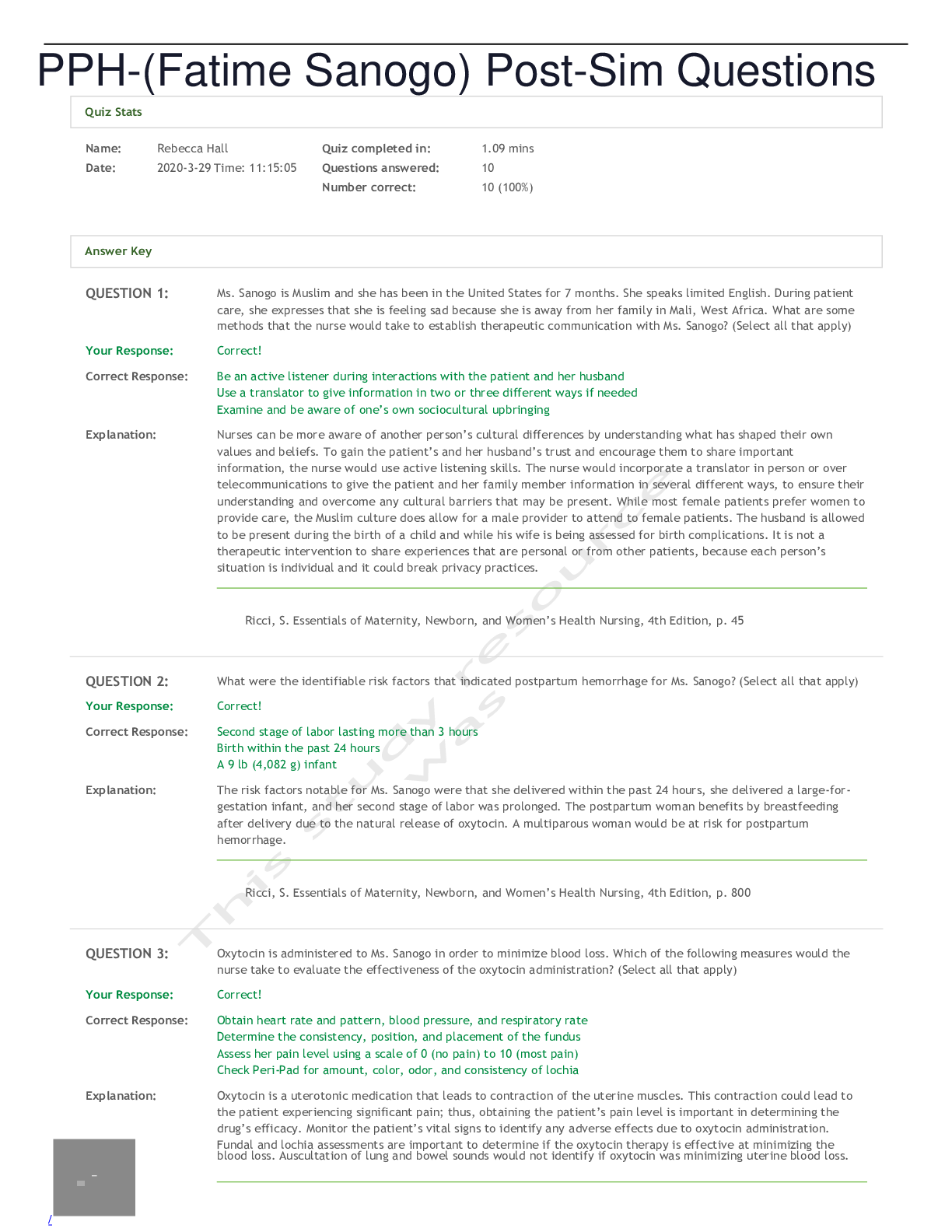
Buy this document to get the full access instantly
Instant Download Access after purchase
Buy NowInstant download
We Accept:

Reviews( 0 )
$14.00
Can't find what you want? Try our AI powered Search
Document information
Connected school, study & course
About the document
Uploaded On
May 10, 2021
Number of pages
3
Written in
Additional information
This document has been written for:
Uploaded
May 10, 2021
Downloads
0
Views
89





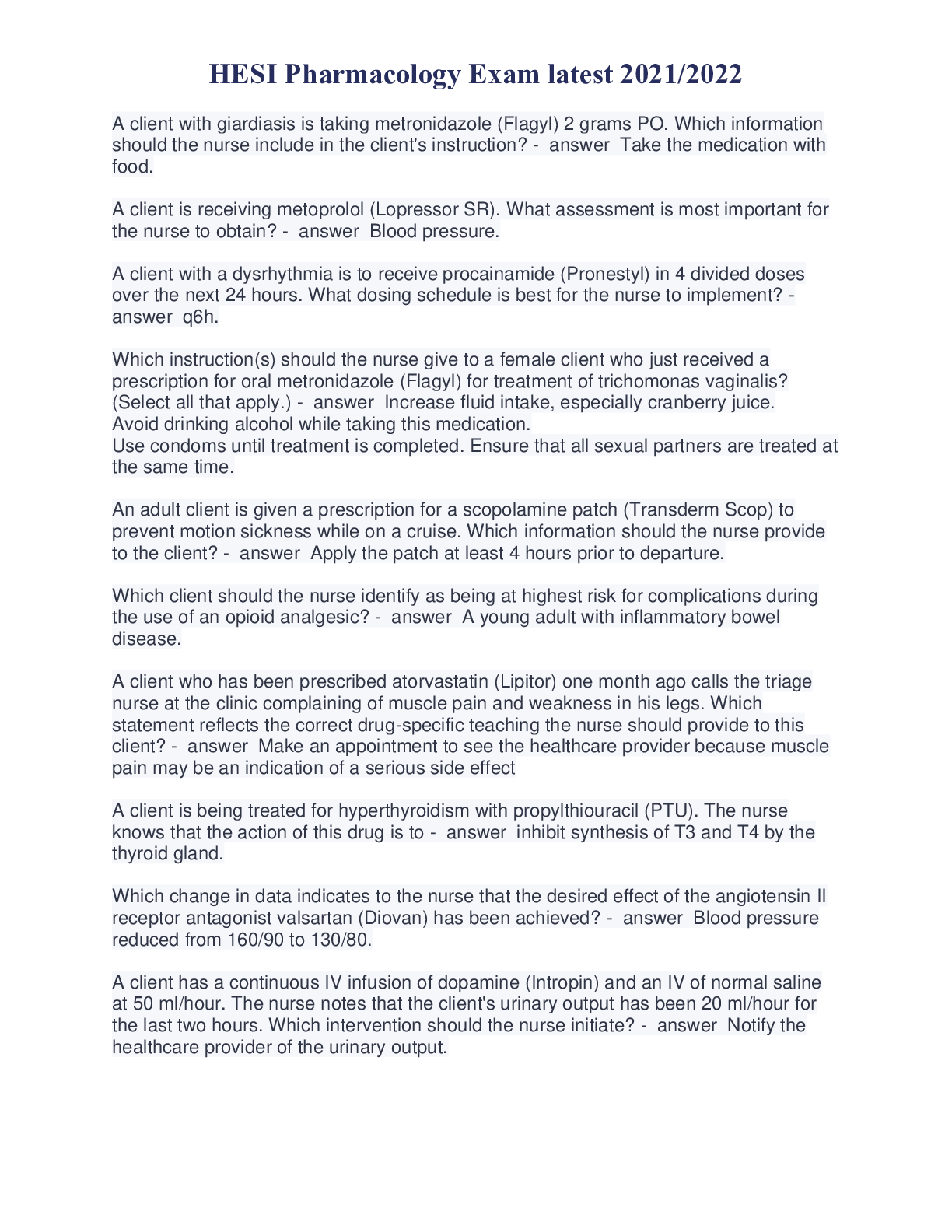
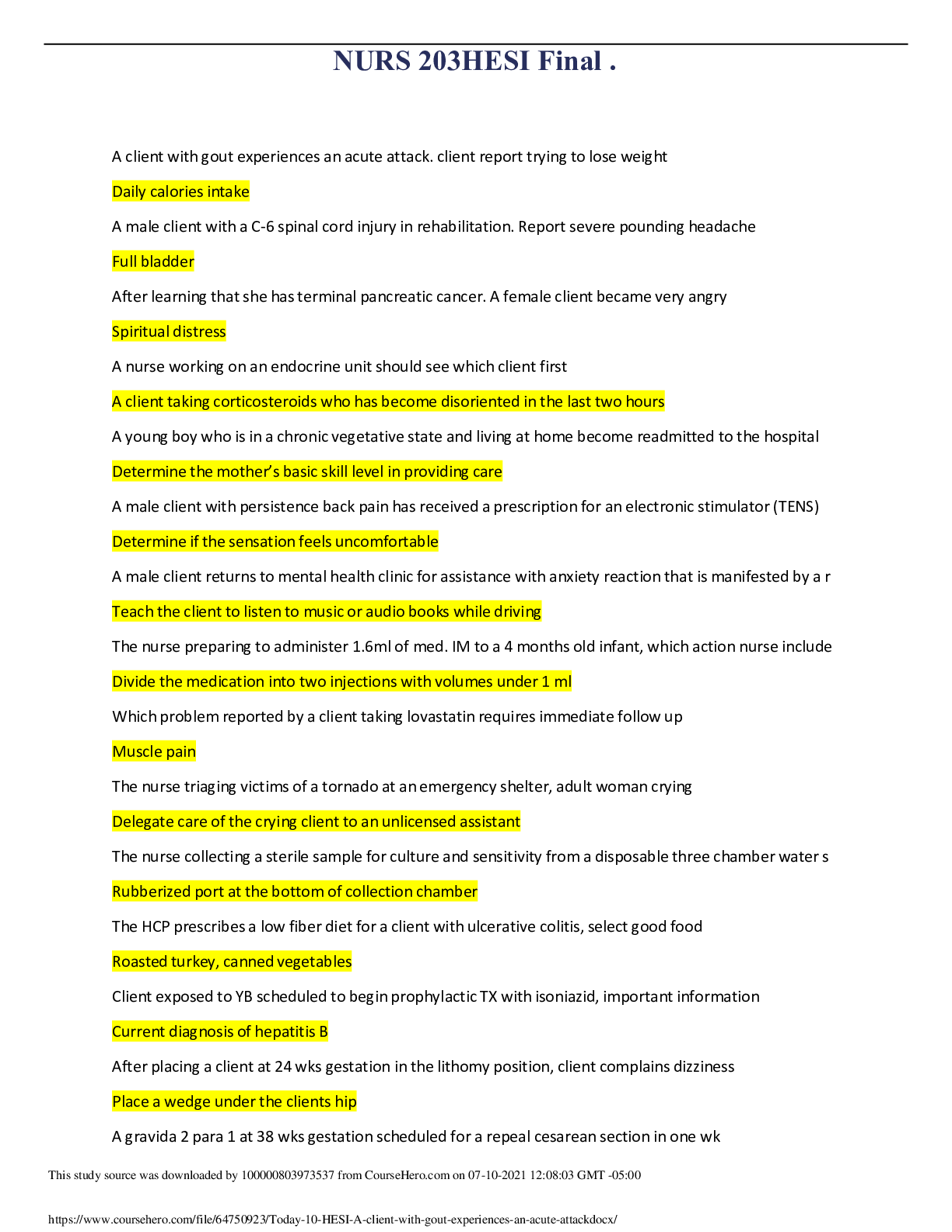



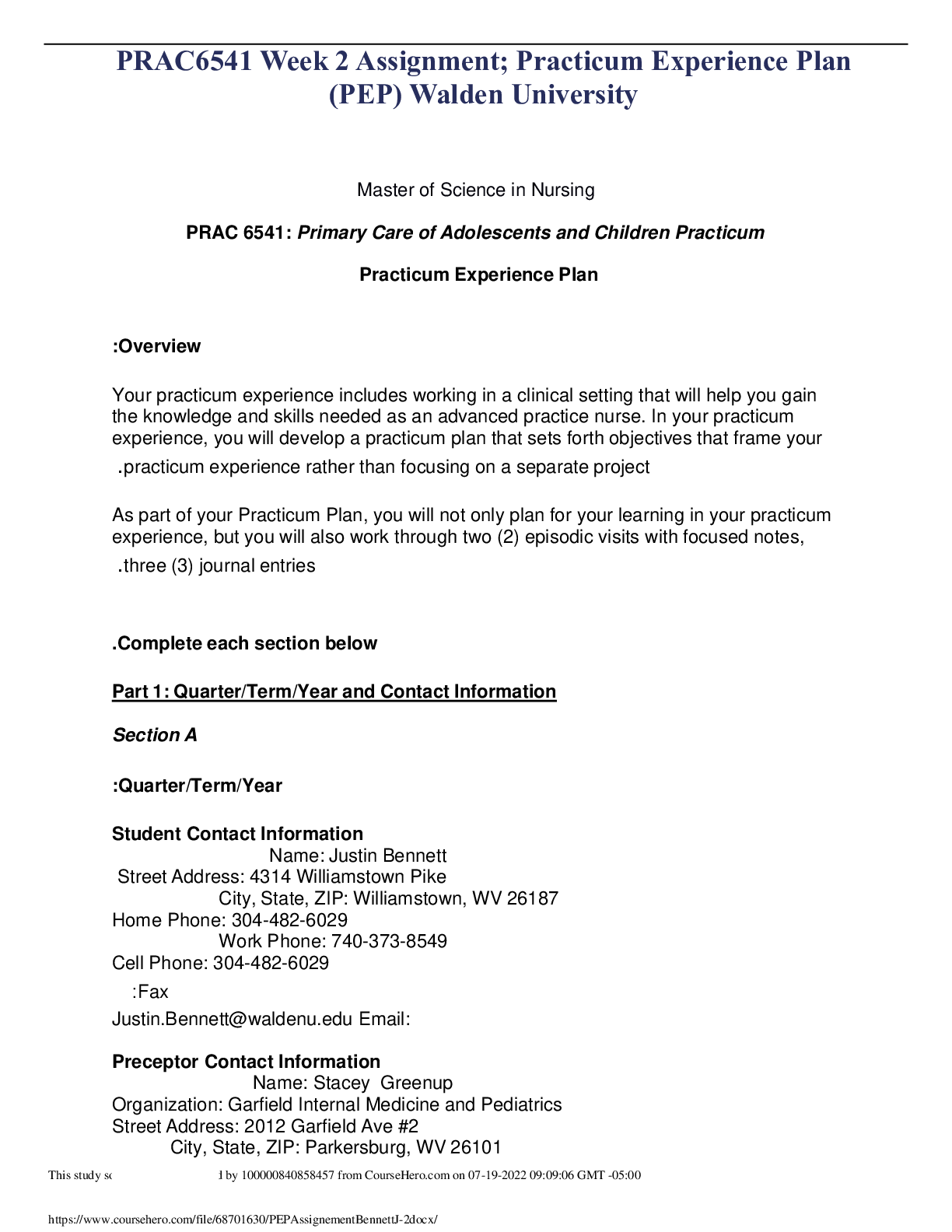
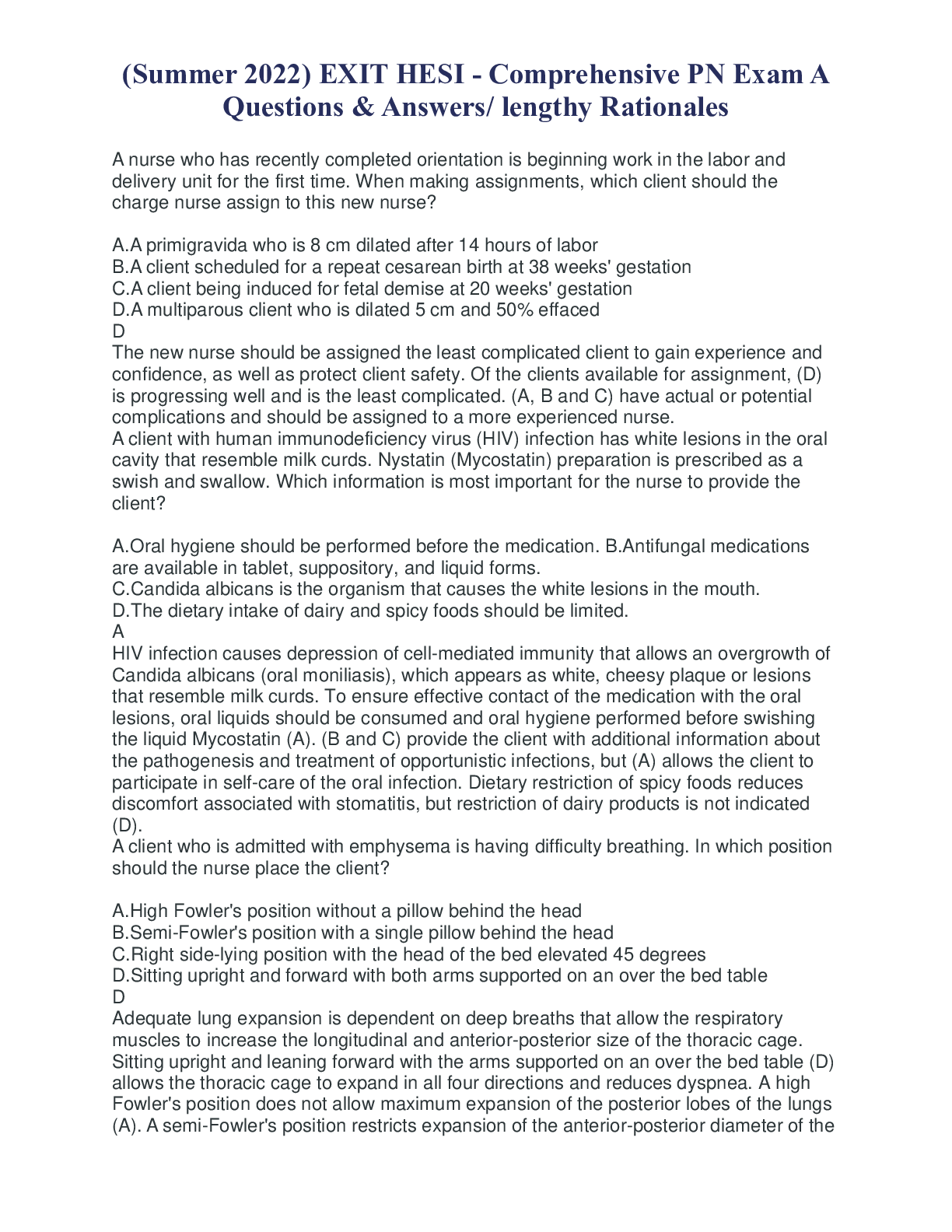
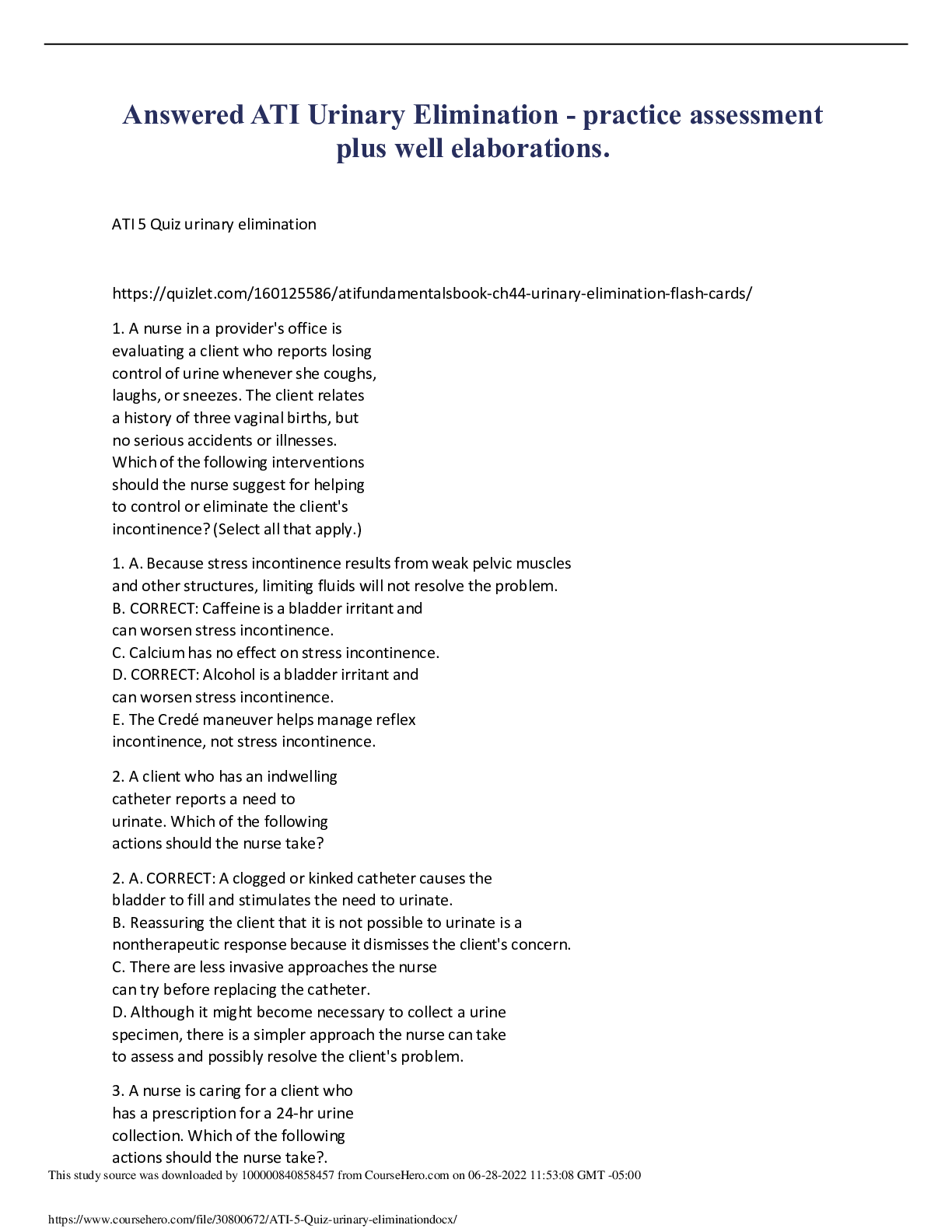
.png)


